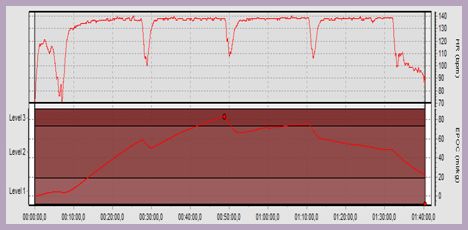Q - Power
Indoor Rowing Team
HR v VO2
Descending EPOC: a consequence of training off HR
An observation often made by those using EPOC (excess post-exercise oxygen consumption) to determine training load is that in heart rate capped rows, EPOC initially climbs during a session but can reach a plateau before even descending again before the end of the training session. This is illustrated in Diagram 1. Why is this happening and what does it mean?
It is useful to remind ourselves why we use HR to measure training intensity. Muscle cells do not respond as a result of heart rate - they do not "know" what your heart rate is. Rather they respond as a result of oxygen throughput and waste production. Directly measuring oxygen throughput presents certain challenges. However thankfully there is good correlation between oxygen throughput and heart rate and so, since heart rate is easy to measure, we use that as an approximation.
A slight difficulty which arises with this system is that the correlation between the two is not set in stone. As a training session continues the relationship between the two will alter. This is illustrated very well in Diagram 2 below. The session in question was a 60 minute time trial but capped at 70%HRR (i.e. the athlete was seeking to cover the greatest possible distance within the HR limitation).
A slight difficulty which arises with this system is that the correlation between the two is not set in stone. As a training session continues the relationship between the two will alter. This is illustrated very well in Diagram 2 below. The session in question was a 60 minute time trial but capped at 70%HRR (i.e. the athlete was seeking to cover the greatest possible distance within the HR limitation).

Diagram 1: This is the HR and EPOC data from a 4x20:00[1:30] HR139 session. The rate of EPOC accumulation during each piece is less than the piece before, and even becomes negative in the last piece.

Diagram 2: HR climbs slowly in the first 15 minutes of the row until the cap of 145 (70%HRR) is reached. Thereafter pace has to be incrementally reduced to maintain a constant heart rate. However the reduction in work done is not only reflected in the falling pace (about 3s/500m was lost in the last 45 minute of the row) - it also shows up in the VO2 data for the same session. Between 10 and 20 minutes oxygen throughput stabilised at about 65% VO2max. However thereafter it began a gradual decline to around 58% VO2max. The reduction in %VO2max is of course to be expected given less work was being done. What is less obvious is that it can be detected from monitoring the R-R intervals used in heart rate variability based training.
The graphs in Diagram 2 demonstrate rather effectively that the relationship between heart rate and work done changes during the course of a longer row. Holding a constant heart rate will lead to a reduction in work rate. This leads to a reduced rate of EPOC accumulation. Thus as the session continues and the rate of work falls, the reducing load takes the pressure off the nervous system which ceases to experience additional strain, and can even fractionally begin the process of recovering.
At this stage it is important to recognise the limitations of EPOC. It gives a good indicator of central load (on the autonomic nervous system) but it will not measure local load, at least not directly. Rowing significant distances can result in the accumulation of a significant amount of both. Training done in a particular session past the point of maximum EPOC may not be adding to central fatigue, but it will doubtless serve as a very important continuing local stimulus - important, because some of the adaptations sought can only be effectively achieved from long rows. By monitoring EPOC, intensity can be controlled to ensure the central cost of those long rows does not get too high.
At this stage it is important to recognise the limitations of EPOC. It gives a good indicator of central load (on the autonomic nervous system) but it will not measure local load, at least not directly. Rowing significant distances can result in the accumulation of a significant amount of both. Training done in a particular session past the point of maximum EPOC may not be adding to central fatigue, but it will doubtless serve as a very important continuing local stimulus - important, because some of the adaptations sought can only be effectively achieved from long rows. By monitoring EPOC, intensity can be controlled to ensure the central cost of those long rows does not get too high.
Never underestimate
the importance of
local training
stimuli.
the importance of
local training
stimuli.

Content copyright 2021. Q-POWER.CO. All rights reserved.
